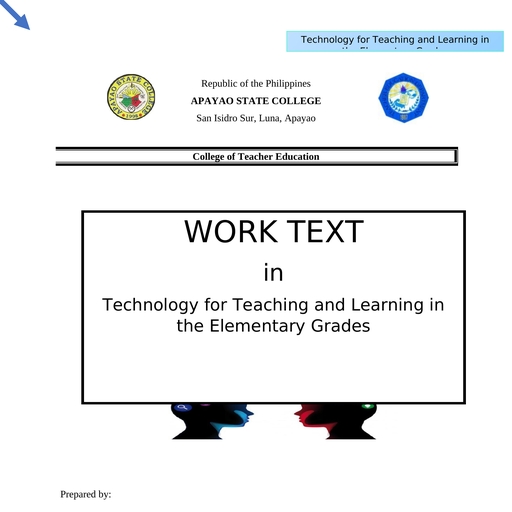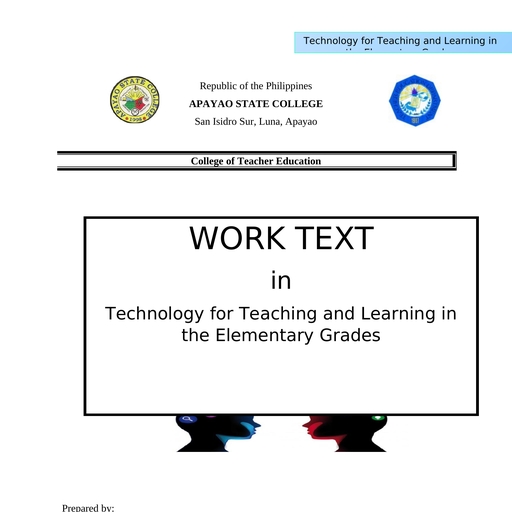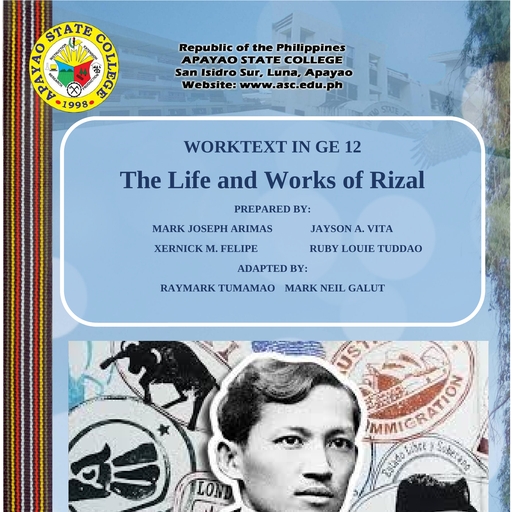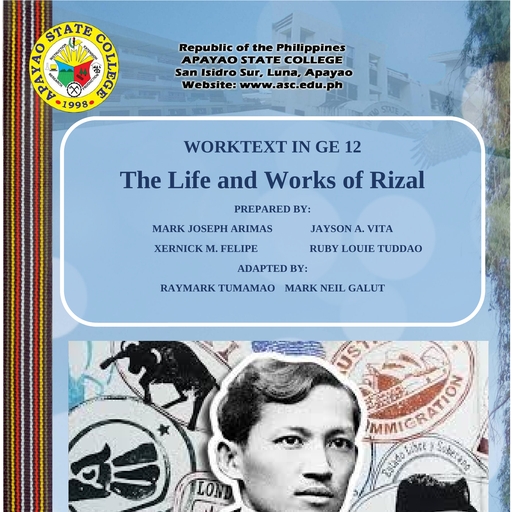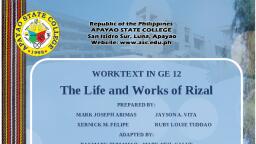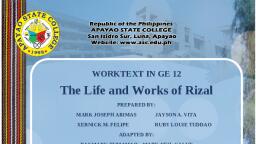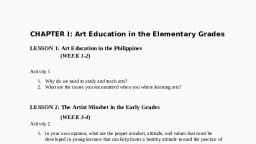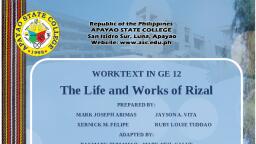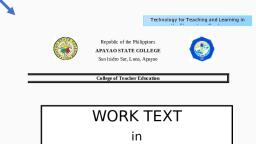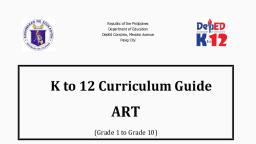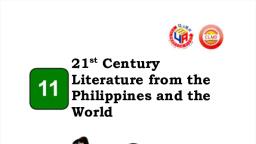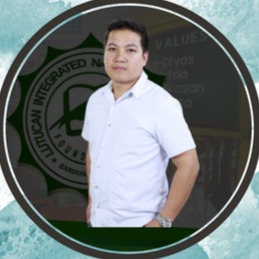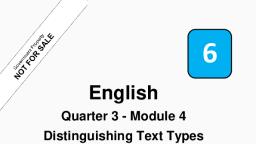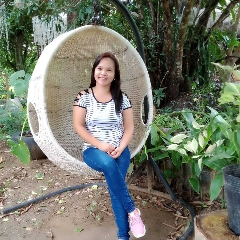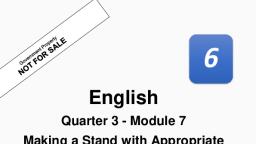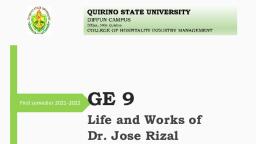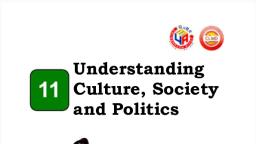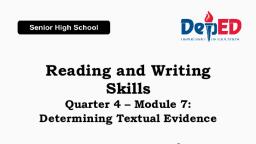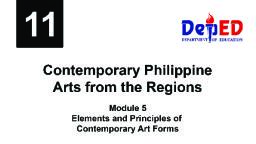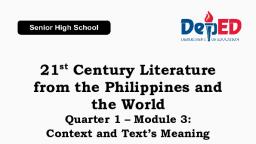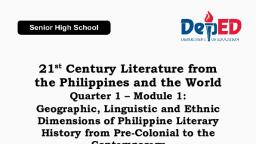Page 1 : Republic of the Philippines, APAYAO STATE COLLEGE, San Isidro, Luna, Apayao, Philippines 3813, asc.edu.ph,www.facebook.com/asceduofficial., APAYAO STATE COLLEGE VISION, MISSION, GOALS AND OBJECTIVES, Vision, “Empowering lives and communities through stewardship for cultural sensitivity and biodiversity”, Mission, Apayao State College is committed to provide empowering and holistic development of citizens by providing quality and innovative instruction, strong research, responsive community engagement and entrepreneurship in order to prime the development of Apayao Province, the Cordillera Administrative Region., COURSE DESCRIPTION:, As mandated by Republic Act 1425, this course covers the life and works of the country’s national hero, Jose Rizal. Among the topics covered are Rizal’s biography and his writings, particularly the novels Noli Me Tangere and El Filibusterismo, some of his essays, and various correspondences., LEARNING PLAN, Instructor’s Note, Good day! I hope that this module finds you healthy and safe during this pandemic. I admired you for pursuing your education even in this time of health crisis. You just proved that there is no greater hindrance to a student who is determined to step up in education and learn. Keep doing it. Your journey to your education will be an inspiration to a thousand of students coming to school., I am excited to be part of your journey to your dreams. Though you can’t come to school and attend classes, I am happy to tell you that I can still assist you in this subject. I am your instructor, Jayson A. Vita under General Education Curriculum Department. If you needed help to understand the topic and have any queries, please don’t hesitate to contact me in my e-mail
[email protected] or you can add me in Facebook with a name Jay Son or you can call or text me through this number 09752440533. I am available to during Monday, Wednesday, Friday at 10:00 am to 11:00am to call or text. If you have no load, just personal message me in messenger. I will do my best to attend to you immediately., This module/ work text you are holding I prepared is free. I made this module as one of the support for your learning. But as an instructor, it’s not just me who is making an effort, I also need your cooperation and support for this subject. Please read this module in your convenient or available time and contact me if you have any queries. Answer the activities given and please send it back to me. When activities are being send back to me with your answers, it means that you are willing to learn and being cooperative in this subject. Don’t worry, I will send back your activities with answers. I hope that this cycle will go on until the last day of the semester ends. When this cycle continues, you and I will not have any problems in the future until your graduation., I pray for God’s provision, protection and wisdom over your life. May you continue to learn and inspire others despite this crisis., Truly yours,, Jayson A. Vita, GE Instructor, Republic of the Philippines, APAYAO STATE COLLEGE, San Isidro Sur, Luna, Apayao, GENERAL EDUCATION DEPARTMENT, 2ND SEMESTER (2020-2021), THE LIFE AND WORK OF DR. JOSE RIZAL, Contents, Republic Act 1425, The Philippine in the nineteenth century as Rizal’s context., Economic: end of the galleon trade, opening of the Suez Canal, opening of the ports to the world trade, rise of the export crop economy, and monopolies, Social: education, rise of the Chinese mestizo, rise of the inquilino, Political: liberalism, impact of the Bourbon reforms, Cadiz constitution, D. Subtopic: seeing the life of an individual in society and society in the life of an individual., Rizal’s life: family, Childhood and Early Education, Rizal’s life: Higher Education and Life Abroad, Rizal’s Life: Exile, Trial, and Death., Prepared by:, Jayson A. Vita, Mark Joseph Arimas, Ruby Louie Tuddao, Xernick M. Felipe, Adapted by:, Raymark Tumamao, Mark Neil Galut, UNDERSTANDING THE RIZAL LAW, LESSON 1: REPUBLIC ACT 1425, Objectives:, Discuss the history of Rizal Law., Identify the important provisions of Rizal Law., Critically assess the effectiveness of the Rizal course., Preliminary Activities:, The students will explain the significance of the following to the life of the Filipinos today., 1. One Peso Coin, 2. Monument of Rizal, 3. Some important Sayings of Rizal, The Life and Works of Dr. Jose P. Rizal flow in each chapter of Philippine history and his love for the country became the inspiration of the Filipinos in different eras. His works served not only the mirror of our society during the time of Spanish colonization but also enlightened the Filipinos to assert their political and civic rights and ask for reform in our society. His brilliance in philosophy gave us another source of principles in analyzing our history and government. His ideas shed light to the Filipino revolutionists and encouraged them to be brave and die for the sake of our country. The greatness of Rizal could be seen in the different eras in history, and in the Philippine Uprising in 1896, in the debate in the American Congress about the annexation of the Philippines and at the present when we need to have the inspiration in achieving our goals for our country., Jose P. Rizal was a well travelled hero; he lived in Europe for eight years and was able to travel to Japan, America and North America. During his travel, he spent his time inside the ship in conversation with other nationalities. Language was not a hindrance to him since he knew 19 different languages. While in Europe, he attended different gatherings where intelligent and known people were involved. He wrote different novels, essays and poem which were published in Europe and circulated in different parts of the world. And on his death, the people who had opportunity to witness his brilliance gave tribute to his greatness., On November 20 1897, at the initiative of Dr. Rudolph Virchow, the president of the Anthropological Society of Berlin sponsored the scientific neurological services to honor Rizal. And the periodicals from different countries published account of Rizal martyrdom to pay tribute to his greatness. In 1902, Congressman Henry Allan Cooper of Wisconsin delivered a eulogy for Rizal and recited one of his work (Ultimo Pensamiento) to prove to the Congress the capability of the Filipino people for the self-government since the race was able to produce a brilliant personality like Rizal. The result of his appeal was the approval of the Cooper Law or the Philippine Bill 1902 (De Ocampo), During the American colonization in the Philippines, Jose Rizal was formally recognized and the Americans gave importance to the contributions of Rizal especially his idea about social reform. The Americans used education as a method of pacification and so with Rizal who viewed education as means of attaining reform. The first American civil governor in the Philippines, William Howard Taft approved the Act No. 137 which organized the politico-military district of Morong into province of Rizal. Taft’s action was in line with their custom of naming the important localities in the memory of the person who had a great influence in the community and in the country. Aside from naming the province of Morong after his name, in 1913 the American government in the Philippines ordered the creation of his monument in Luneta whoch marked the origin of the distance of the places in the Philippines (Kilometer Zero), The worth of a hero could not be known to different generations if the people did not have a clear understanding of his life, struggles and writings. The life of Dr. Jose P. Rizal was well documented since he left numerous numbers of writings, a diary and a lot of correspondence to his family and friends. In July 1956, Jose P. Laurel, Claro M. Recto, Jose B. Laurel Jr., Jacobo Gonzales, Lorenzo Taneda and other lawmakers sponsored the Republic Act 1425 that would enforce the teaching of the Life and Works of Jose P. Rizal in all public and private schools, college and universities. This law was implemented on August 16, 1956 by the National Congress of Education and was known as Rizal Law., EXERCISES:, Write a concept paper about the relevance of the Rizal course in our era/generation, Identify situation which you can use the teachings of Rizal, Format of the Activity:, I. Introduction, II. Teachings of Rizal (at least 5), III. Application to Current Situations, IV. Conclusion, RUBRICS, The Philippines in 19th century as Rizal’s Context, LESSON 2:THE SYSTEM OF GOVERNMENT IN THE PHILIPPINES, Objectives:, 1. Appraise the link between the individual and the society., 2. Analyze the various social, economic, political and cultural changes that occurred in the 19th century Philippines., 3. Understand Jose Rizal in the context of his time., The System of Government in the Philippines, The Spanish colonial government in the Philippines ran indirectly through the viceroy of the Spain in Mexico. The viceroy was the one who appointed the Governor General in the Philippines. The Governor-General was the chief executive in the whole archipelago and the head of the military. He had the power of cumplace or the power to choose the law that he implemented. Because the Spanish government gave a lot of power to the Governor General, they assigned two positions that would check the administration of the Governor General. The Visitador who visited the country to check the administration of the Governor General and the Residencia who lived in the Philippines to observe the Governor General., The whole archipelago was divided into different provinces and each province had the Alcalde Mayor as the head of the political unit. The Alcalde Mayor had the power and responsibilities like the Governor General but its power was limited only in the province. The provinces were still divided in a smaller political unit headed by the Gobernadorcillo. The power and responsibilities of the Gobernadorcillo was the same as the Governor General, however, hi spower was limited only in the town or pueblo. Each town was still divided into smalle unit called Barangay and it was headed by the Cabeza de Barangay. The Filipino was allowed to assume the position of Gobernadorcillo and Cabeza de Barangay only and only given to Filipino male, 23 years old, educated and had a property of 500 pesos. The Royal Audencia was the highest court in the county and supervised the other courts but in reality, there was no equality in the Filipino and Spaniard in the context of law. The Spanish had centralized government in the Philippines, however, aside from the government, there was a highest decision-making body in the country composed mostly by the friars. So, they had the opportunity to dominate the society and the government., The Rise of Liberalism in Spain and Philippines, The Political Situation in Spain, In the early 1800, the Spain was experiencing political instability due to successive rise and fall of the leaders brought by the conflict between the Liberals and the Conservatives. The changes brought by the enlightenment and the territorial disputes made a change in the perspective of the people towards the government., In the span of Rizal’s lifetime, there were continuous changes in the monarchy of Spain:, 1. The last reign of Queen Isabel II (1861-1868), 2. The rule of Marshall Serrano as Regent of Spain (1868-1871), 3. The reign of Amadeo I (1871-1873), 4. The period of the Spanish Republic (1873-1874), 5. The Bourbon Restoration and reign of Alfonso XII (1875-1885), 6. The regency of Queen Maria Cristina (1885-1896) (Zafra, 1956), The “Los Afrancesados” were the well-educated elite who asked for liberal reforms in the government and the result of their struggle was a constitution with a more liberal idea of the government., The Cadiz Constitution of 1812 mandated the transformation of the Spanish government from the monarchy to the constitutional monarchy, the parliamentary system in the creation of law, division of power in the government, equality, free trade, competition and the divestment of properties held in mortmain or the properties from the church and other institution., The social and political transformation in Spain paved the way to the rise of different groups which later on affected the political situation in the Philippines and influenced Jose P. Rizal as he ventured to Spain to pursue his studies and to do his mission. The First group was the Illustrados (The Enlightened Ones) they were the intellectuals who aimed to introduce reform for the development of Spanish civil life and chosen by King Carlos III, they believed that through education the society could attain reform., The second group was the Progresistas, most of them were freemasons who believed that the hindrance for the attainment of development were the absolutism of monarchy, the ignorance of the people and the intercession of the friars in the political and social life of the people. The Third groupThe first American civil governor in the Philippines, William Howard Taft approved the Act No. 137 which organized the politico-military district of Morong into province of Rizal. of Spain also affected the political situations in the Philippines., The Political Situation in the Philippines, The constant change of the governor general in the country became the hindrance of gaining the stability of colonial government in the Philippines which resulted to the failure of the implementation of the needed reforms in the country. The end of the domination of the Spain to the Latin Americans resulted to the migration of the Spaniards from the said territory to the Philippines and the posting of incompetent officials in the Spanish colonial government in the Philippines led to rampant corruption in the government. In fact, there was an instance when the appointed oidor of the Royal Audencia was terminated before he could reach the Philippines and assume office., The Social Stratification in the Philippines, Spaniards who were born in Spain and settled in the country occupied the highest class in the society and the position in the government, they built their community in Intramuros and enjoyed all the privileges in the country., Spaniards born in the Philippines, and were the second class in the society, also enjoyed the luxuries in the Philippines., Creoles/Illustrados class was the third class they were a mixture of the Spanish and native, this was the group of Jose Rizal, the GOMBURZA and other Filipinos who sought reform in the society during the Spanish colonization belonged., - - They are the lowest class in the society and was the natives here in the Philippines., The Economic Development, Wealthy Filipino families were engaged in the international trade. The business in line with agriculture attained development because of the opening of Suez Canal and development in the international trade. However, because most of the lands intended for agriculture were under the control of the friars, they had the opportunity to increase the rent in the land that resulted to the decrease in income of the Filipino elites. The father of Jose Rizal, Francisco Mercado was an Inquilino, he rented a big land in Calamba from the Dominican friars. And when the Dominicans increased the rent in the land, Francisco refused to increase the rent of the farmers under his administration. So the family of Rizal suffered because of the decrease in their income., The Advent of Nationalism in the Philippines, Definition of Nationalism, Nationalism is a sentiment of a person towards his country. It is a display of loyalty of a person to his own culture, history and aspiration as a nation. It is a national sentiment that unites the people towards a common goal for the advancement of the country. Nationalism could be attributed to growth of national consciousness brought by the various events which challenged the pride of the people and the rise of the Creoles and the well educated Filipinos who wrote different seesaws articles and novels that challenged the community to rise and assert their rights and ask for political reforms., The Factors that Led to the Rise of Nationalism in the Philippines, A. The Opening of the Philippines in the World Trade – The opening of the Philippines in the world trade was on important factor in the rise of nationalism in the country because of two reasons:, 1. The international trade brought material progress in the different areas in the Philippines where the agricultural products included in the trade came from. The increase of the demand in the agricultural products brought prosperity to the provincial elite and this development made them capable of sending their children to universities in Manila and in Spain., 2. The reason was that the world trade gave opportunity to the Filipinos to gain knowledge about the other parts of the world as well as the political events and liberal ideas., B. The coming of the Liberal Ideas, 1. The Administration of Carlos Maria De La Torre – A liberal-minded governor general in the Philippines, during his administration, he encouraged the Filipinos to participate in the government and expressed their sentiments for the development of his administration. This method of governance became an eye-opener to those who experienced his liberal administration. The liberal administration of De La Torre ended and he was succeeded by a conservative governor general Rafael Izquierdo who imposed rules opposite De La Torre. The sudden shift from liberal going to conservative gained negative reaction from the Filipinos., 2. The Issue of Secularization – The secularization issue started in the times of Archbishop Sta. Justa and Governor General Anda (1767-1776). The problems about the vacancies in the numerous churches were solved by the appointment of Filipino priests and this decision of the archbishop was supported by Governor General Anda. This was criticized by the regular priest who questioned the credibility of the Filipino priest in leading the church. The secularization issues gave birth to the popularity of the spokesperson of the Filipino priest Fr. Burgos, Fr. Zamora and Fr. Gomez and put them in conflict with Spanish priest., 3. The Cavite Mutiny – Rafael de Izquierdo cancelled the benefits enjoyed by the Filipino soldiers in Cavite like the exemption in tribute and personal services. This resulted to the unrest of the laborers in the Cavite arsenal. The event was popularly known as Cavite Mutiny; this uprising was of local character and was quickly suppressed. But the mutiny was used by the Spanish authorities against the Filipino reactionaries like the GomBurZa., 4. The Execution of GomBurZa – They were accused as the leaders in Cavite Mutiny. Francisco Zaldua testified against the three priests. Father Gomez was the head priest of Bacoor, the second richest parish in Cavite in terms of the tributes collected. He served in the said parish for forty-eight years and was loved by the people because of his dedication. Father Jacinto Zamora, the head priest of Marikina, he was also part of the secularization movement and supported the struggle of the Filipino priest for equality and opportunity to lead a church. Father Jose Burgos the youngest among the three and friend of Paciano Mercado, the brother of Rizal. He became the leader of the secularization movement after the death of the father of secularization, Father Pedro Pelaez., GOMBURZA, B. The Implementation of Different Unjust Policies, 1. Polo Y Servicios – All males 16-60 years old ere obliged to work for the government for 40 days every year but the Royal decree in 1883 increased the minimum age of the males who worked as polista from 16 to 18 years old. However, those who could afford to pay falla (the amount money paid to the government to be exempted from forced labor) were exempted to perform the manual labor implemented by the polo., 2. Encomienda – The land of the natives was confiscated and was given to the Spaniards, the natives who were part of the land were subjected to the policies of the encomiendero and to the taxation. The farmers were not allowed to work in their land without the permission of the said officials., 3. Hacienda Owned by the Friars – The hacienda emerged after the abolition of encomienda. The descendants of the enconmiendero transformed the land as their hacienda. And those enconmienda under the church was transformed as hacienda of the friars., 4. Bandala – The compulsory sale of products of the natives to he Spaniards., 5. Tributo – Tax obligation to the government in money or in kind., D. The Maladministration of Justice – The Spanish colonial government in the Philippines had a Penal code as basis for the justice system in the government, however, in most of the cases the accused was sentenced without the due process of law., E. Racial Discrimination – Spaniards brought racial discrimination and the usual victims were the Creoles and the Indios. In the church, the Filipino priest needed to pass the examination before he cold be appointed as a parish priest while the Spanish priest could assume the position of Parish priest even without examination., F. The Lack of Representative of the Filipino in the Spanish Cortes – One of the political reforms that Jose P. Rizal asked for was the representation of the Filipinos in the Spanish Cortes. The laws formulated for the Filipinos were suited in the culture of the people and having a Filipino as representative in the Spanish Cortes could be the way to have laws that would protect the interest of the Filipinos and could elevate their situation under the law., Film Viewing: Title:“Ganito Kami Noon, Paano Kayo Ngayon”, Source: Youtube/ Google, EXCERCISES:, I. Answer the following questions., 1. What is a vice royalty?, 2. What is gobernacion?, 3. Kind of government was established in the Philippines during the Spanish regime?, 4. What is a gobernadorcillo?, 5. What is bandalla?, 6. What is the system of land own imposed by the Spaniards?, 7. What is Nationalism?, 8. What was the reason why GomBurZa got executed?, 9. Whait is falla?, 10. What is the age that a male required to work in Polo Y Servicio?, II. TRUE or FALSE. Write T if the statement is True and F if the statement is False., 1. The Creoles class was the group who enlightened the citizens about the needed political reform in the country., 2. The Filipinos in Madrid were united in one vision for the development of the country., 3. The political instability in Spain was brought by the union between the Carlista and the Liberal group., 4. The conservative group supported the confiscation of the properties of the church., 5. The political instability in Spain did not affect the Spanish colonial government in the country., 6. The Peninsulares were the Spaniards who were born in Philippines with a Filipino Mother., 7. Cedula was one form of taxation., 8. The Filipinos had representatives in Spanish Cortes., 9. Hacienda was owned by the Filipinos., 10. The secular priests were the Filipino priest., III. Reflection: Reflect on the following question base on the movie you watched., Describe the nineteenth-century Philippine as represented in the film., Based on your readings, what can you say on the film’s representation of the nineteenth century?, What is the main question that the film seeks to answer?, What is your own reflection based on the film and your understanding?, RUBRICS, RIZAL’S LIFE, FAMILY, CHILDHOOD AND EARLY EDUCATION, Objectives:, 1. Analyze Rizal’s life, family, childhood and early education., 2. Evaluate the people and events and their influence in the early life of Rizal., LESSON 3: Birth of a Hero, Jose P. Rizal (Jose Protacio Rizal Mercado Y Alonso Realonda) was born on the 19th day of June 1861 between 11:00-12:00 midnight. His mother Teodora Alonzo almost lost her life in giving birth to Jose because of his big head and because of this difficulty, the family of Jose considered him as special and called him as muy bonito. He was born in Calamba, Laguna, which was considered a first-class municipality and a place where the rich families enjoyed the material progress brought by the opening of the Philippines in the world trade. He was born in a time where well-educated Filipinos were starting to ask for reform from the Spanish government in the Philippines. The different events during his time enriched his liberal ideas and sharpened his knowledge about the true government., The Mixed Ancestry, Jose came from a mixture of Chinese, Spanish, Japanese and Filipino blood. His great grandfather in the father side was Domingo Lamco, a Chinese immigrant from China who married Ines de la Rosa, a Chinese Christian girl from Manila. Domingo adopted the surname Mercado (Spanish term for market). The son of Domingo and Ines, Francisco Mercado resided in Binan and married a Chinese woman named Cirila Bernacha. He was elected as gobernadorcillo of Binan and later on, his son Juan Mercado followed his footstep as the gobernadorcillo of the town. Juan also married a Chinese Filipina named Cirila Alejandro. The couple was blessed with thirteen children and one of those was Francisco Mercado, the father of Jose Rizal. At the age of eight, Francisco lost his father and grew up under the care of his mother. He studied Latin and Philosophy at College of San Jose in Manila and fell in love with the student from the College of Santa Rosa, named Teodora Alonzo. Teodora Alonzo came from the family of Lakandula. Her great grandfather Eugenio Ursua who had a Japanese ancestry married Benigna. The daughter of Eugenio and Benigna was Regina who was married to a prominent Spanish name Lorenzo Alberto Alonso from Binan. One of the daughters of Lorenzo and Brigida was Teodora Alonzo., Both parents of Jose P. Rizal had Chinese Ancestry. And after their marriage on June 28, 1848, they settled in Calamba and engaged in farming business. They were blessed with eleven children namely, Saturnina, Paciano, Narcisa, Olimpia, Lucia, Maria, Jose, Concepcion, Josefa, Trinidad and Soledad., Rizal’s family belonged to the middle class or a principalia class or a creoles class. The status of his family brought a comfortable life to Jose, their house was made of adobe and hardwood, they owned a carriage and horses which were the symbols of wealth during those times, Jose had ten siblings and all of them were educated in Manila and still his parents enhanced the innate intelligence of Jose Rizal in becoming well-educated and because of his knowledge he would someday enlighten the Filipino to assert their rights and ask for reform in the government., The Childhood Memories, His childhood memories were full of happiness because of the care and love of his family. And because of his health condition, his parents employed an aya (nurse maid) who looked after his comfort. His aya told him a lot of stories about the fairies, aswang, nuno and the tikbalang. When he was four years old, he experienced his first sorrow because of the death of his little sister Conchita. It was the first time that he shed tears caused by love and grief. He learned to read and write at the age of three with the help of his mother, his first teacher., The Story of the Moth, The story of The Moth and the Flame is not the only part of his childhood which became true in his lifetime. One instance during his childhood, he made a small monument of himself and because of that his sisters laughed at his work. In between sobbing, he told them that someday he would have a monument build by other people. In the future, the prediction of Jose Rizal became true and he had monuments in different parts of the country and also abroad., Journey to His early Education, At the age of three, the young Jose already knew how to read and write. This was because of his mother who took care of his first education. His mother also hired private tutors to enhance the learning and talent of Jose Rizal. However, his education learned from home was not sufficient so his father Don Francisco decided to send him to the fishing village in Binan for his primary education. June 1869, at the age of eight, Jose P. Rizal needed to leave his family to study in Binan. With tears in his eyes, he left Calamba and his brother Paciano accompanied him to Binan. The two brothers rode the carromata for one and half hour, they arrived in Binan. Jose lodged in the house of his aunt Isabel. The beautiful scenery in the place did not appeal to the young Jose because of his homesickness., First Day in Binan, His school was thirty meters away from the house of his aunt and also the house of his teacher Maestro Justiniano Cruz which was describe by Rizal as tall, thin, long necked, with a sharp nose and body slightly bent forward, and he used to wear sinamay shirt and he knew by the heart the grammar by Nebrija and Gainza. He experienced being scolded by Maestro Cruz because he was asked if he knew Latin and Spanish and he answered “um poco” or a little. His Maestro wanted that his students should study their lesson and be ready before coming to school so he had the reward and punishment as his method of teaching. For Rizal, the sadistic method of learning was beneficial since he was encouraged to study harder and perform above what was expected., A Victim of Bullying, After the incident in the classroom, young Jose met the bully, Pedro, who challenged at him during his conversation with Maestro Cruz. Jose challenged Pedro to a fight and latter accepted because he thought that he could beat Jose for he was smaller than him but Jose learned the art of arm wrestling from his Tiyo Manuel so he was able to defeat a taller boy than him. After the fight he gained respect from other classmates. Jose Rizal developed the other aspects of his personality to avoid bullying, to compensate for his small physique; he studied arm wrestling, fencing and various aspects of arts., Success in Binan, Because of his intelligence and perseverance, he became the top student in his class and gained the admiration of his teacher. After his class with Maestro, he had a painting lesson with old Juancho. He was able to improve his painting skills and became one of the favorite painters in the class. Young Jose experienced the simple and usual life like other normal children. His training and happy memories were the foundation of his personality. Although he disapproved of the sadistic method of teaching as he stated in Noli Me Tangere but the discipline that he gained from this method contributed a lot as he pursued higher education., EXERCISES:, I. Write an essay about the impact of childhood, family, and early education of Rizal to his success as a person and as a hero., RUBRICS, II. In a 1/8 illustration board, draw a family of Rizal., RIZAL’S LIFE: HIGHER EDUCATION AND LIFE ABROAD, Objectives:, Describe the life of Rizal in Ateneo and in UST, Explain the principle of assimilation advocated by the Propaganda Movement, Appraise Rizal’s relationship with other Propagandists, Analyze Rizal’s growth as Propagandists and disavowal of assimilation, LESSON 4: Success in Ateneo de Municipal (Ateneo de Manila University), Jose Rizal had his Bachiller en Artes at the school of the Jesuits, this religious order loved Rizal so much. Jose Rizal was again accompanied by his brother Paciano to Ateneo Municipal. He was introduced to Father Minister Magin Fernando and at first, the Father Minister did not want to accept him. However, with the help of Manuel Jerez, the nephew of late Father Burgos, the eleven-year-old Jose Rizal was accepted in Ateneo Municipal., The teachers in Ateneno encouraged their students to study harder with the use of competition. The class was divided into two groups, the Carthaginian (the non-boarder of Ateneo) and the Roman (the boarder inside Ateneo). The best students in each group was called as the Emperor, the second best was Tribune, the third best was the Decurion, the fourth best was the Centurion and the fifth best was the Standard Bearer. In the first quarter of his stay in Ateneo, he already achieved the title Emperor. The challenge of competition had a positive effect to the academic status of Jose P. Rizal and this was evident in his scholastic records., (Grade of Rizal in Ateneo de Municipal), Extra-Curricular Activities in Ateneo, He was part of the literary group under the guidance of Fr. Sanchez, a member of a Marian Congregation who were devoted to Virgin Mary, a member of the club of Natural Sciences. He also continued his painting lessons under Agustin Saez, and he also studied sculpture under the guidance of Romualdo de Jesus. He also was able to read and understand complicated novels like The Count of Monte Cristo written by Alexander Dumas. He also read books in different areas, Universal History and Travels in the Philippines., Literary Works of Jose Rizal in Ateneo, My First Inspiration 1874, Through Education the Country Receives Light 1876, Intimate Alliance Between Religion and Good Education 1876, St. Eustache, the Martyr 1876, Memories of My Town 1876, College Life in Universidad de Santo Tomas, He entered the university as a student of Philosophy and Letter. He was not sure of the course that he would pursue in college so he sought the advice of his former teacher in Ateneo, Fr. Ramon but because the latter was in Mindanao his teacher was not able to reply to his question immediately. Following the course of his father he took Philosophy and Letters from 1877-1878 and in 1878 he shifted to Medicine course because he considered the situation of his mother who had failing eyesight. Even if he was enrolled in UST he spent his other time going back to Ateneo to continue his extra-curricular activities and in 1877-1878 he used his spare time in UST to study vocational course. In Ateneo, he studied surveying course and gained the title of Perito Agrimensor., (Rizal’s Grade From UST), His grades in UST was lower than in Ateneo because of discrimination that he experienced in UST. However according to Villaroel and De Viana, Jose Rizal was not discriminated in UST because among other students, he was able to get higher grades. The story of Placido Pinetente in Physics class did not happen in UST because personally Rizal took Amplication so he did not take Physics in UST, the reason why Rizal got lower grades in UST was different distraction that he experienced while studying in UST like his love life and group that he established (Compadrenismo)., The Literary Triumph of Rizal in UST, El Consejo de los Dioses (1880) – a play which recognized Cervantes as equal to Homer and Virgil and even if the jury was composed of Spaniards, they awarded Rizal the highest prize, the time of the awarding the crowd which was composed of the Spaniards did not applaud Rizal., La Juventud Filipina (1879) – this poem encouraged and inspired the Filipino youth to stand up and work harder to attain the highest objectives., The First Journey to Europe, The secret mission to Spain was the agreement between Jose and Paciano. Jose decided to follow the advice of his brother Paciano to leave the country and travel to Spain. The First reason why he needed to leave was to pursue his medical course and Second was to observe the political situation in Madrird. It was only Paciano, Antonio Rivera, his friend Chenggoy and the family of Orang who knew about his departure. His passport was named Jose Mercado and a first class ticket for the cruise Salvadora. On May 2, 1882, he visited the family of Orang. Orang’s mother gave him a can of cookies called sopas and a box of chocolate that he would consume on his travels. The night before he left, he had opportunity to talk to Orand Valenzuela., On May 3, 1882 at 5:00, he heard Mass at Santa Domingo church and then Chenggoy, Antonio Rivera and his cousin Gella accompanied him to the dock near Magallanes monument. He rode the cruise Salvadora. May 8, 1882, their cruise reached Singapore, he travelled to different parts of the country. He admired Chinese architecture and the freedom of religion in Singapore., On May 11, 1882, he rode the cruise Djemah going to Ceylon (old name of Sri Lanka). They reached Ceylon on May 17, 1882, Jose was enchanted because of the beautiful scenery in the island and according to Rizal this was one of the most beautiful islands that he had seen. From Ceylon they travelled to North Africa and Rizal described Africa as a country with hot climate. Then they travlled to Suez Canal for five days. Their next stop over was in Port Said in Egypt, in this place Rizal observed the multicultural city since he saw different people speaking in different languages like Arabic, Greek, Italian, Spanish and Egyptian., On June 11, 1882, Djemah reached Naples in Italy. Rizal admired the panoramic beauty by the bay and then their cruise reached Marsilles. After three days, he travelled to Barcelona using train. On June 16, 1882, he reached Barcelona and he learned that he ran out of cash and the money that left to him was only seven pesos. However, when his brother Paciano was able to send him money, he transferred to a more expensive room that suited his taste., Life in Barcelona and Madrid, Since he arrived in Spain during the summer vacation, he had the opportunity to travel to different parts of the city and meet other Filipinos living in the City. He wrote his first nationalistic essay in Barcelona entitled El Amor Patrio. This essay was published in Diariong Tagalog on August 20, 1882 and was translated in Tagalog by Marcelo H. del Pilar. His brother wrote to Rizal to remind him about his secret mission in going to Spain. On November 3, 1882, Rizal was enrolled in Unibersidad Central de Madrid under the course of Medicine and Philosophy and Letters. Aside from his studies and other art lessons, he had the opputunity to meet Consuelo Ortiga y Perez, the daughter of Don Pablo, the former mayor of Manila. He fell in love with Consuelo but he did not pursue his feelings., Rizal Joined the Masonry, In Madrid, Rizal was able to meet different personalities with liberal ideas like Miguel Morayta, Francisco Pi y Margal and other people who were brave to openly criticize the government and friars during their time. And these people were part of the Masonic Lodge so Rizal also joined the Masonry hoping that he could utilize the Free Masonry as his shield against the friars who according to him were the hindrance for the development and reform of the society in the Philippines. On February 15, 1884, he received his diploma as the Master Mason., Rizal, Assimilation and Propaganda Movement, The Filipino Illustrado in Madrid between the year 1880 to 1885 had a secret mission to inform the Spanish government in Madrid about the true condition of the Philippines under their colonial government. This is due of their assumption that the administration of Spain is not aware about the abusive policies of the assigned Spanish officers in the Philippines., (Filipino Illustrados), Equipped with high education and literary talents, the Filipino Illustrado contributed articles to their newspaper, La Solidaridad to enlighten the minds of the Spaniards and other Filipinos about the real condition of the country. The triumvirates of the organization were Marcelo H. del Pilar, Graciano Lopez Jaena and Dr. Jose Rizal. Among the contributors of the newspaper, it was Jose Rizal who was the most diligent in writing and brave to defend the Filipinos., The Conflict between Antonio Luna, Wenceslao Retana, Marcelo H. del Pilar, Luna and Rizal were close friends but when Luna knew that Nelly Boustead, the lady whom he was courting had special feelings for Jose Rizal their friendship was shaken. In one incident, when Antonio was drunk, he stated negative things about Nelly, so Rizal challenged Luna to a duel, but the Filipinos present prevented the duel to happen. After the incident Antonio talked to Rizal and help him to win the heart of Nelly Boustead., Wenceslao wrote an article which stated that the Dominican friars evicted Rizal’s family from their land in Calamba which they rented from the Dominican because Rizal’s family did not pay enough amount to the corporation. And because of the negative comments of Retana about his family, he challenged Retana to a duel but again having in mind that Rizal was an expert in gun ad sword, Retana did not agree to the challenge., Marcelo and Rizal had a conflict because of leadership. The members of the association were divided as Pilarist and Rizalist and to end the conflict they held an election. On all of the three elections Rizal won the votes, but he did not accept the leadership because of the lack of unity. The conflict between Rizal and Pilar was published in La Solidaridad which was opposed by Rizal., EXERCISES, I. TRUE or FALSE. Write T if the statement is correct and F if the statement is incorrect., 1. Rizal’s mother encouraged him to pursue his education in Universidad de Santo Tomas, 2. He entered Universidad de Santo Tomas as a Philosophy student, 3. He had busier schedule in UST than when he was in Ateneo Municipal, 4. He asked the advice of Father Ramon regarding his course that he would take up in UST, 5. His academic performance in UST was better than when he was in Ateneo, 6. He continued his vocation course in Ateneo while pursuing his degree in Philosophy in UST, 7. Rizal took the Ampliacion in UST, 8. Jose Rizal wrote the play entitled, El Consuejo de los Dioses and joined the competition which commemorated the 400th death anniversary of Miguel de Cervantes., 9. Rizal won the Artistico-Literario Manila and wrote the poem entitled, Through Education Our Country Receives Light as his entry., 10. Rizal’s triumph in the literature was accepted by the Spaniards who also joined the competition., II. IDENTIFICATION: Identify the questions that being asked., 11. The head doctor of the eye clinic where Rizal took his training in France, 12. The Family which Rizal often visited during his stay in France, 13. The distinguished German ophthalmologist Rizal worked with in Heidelberg, 14. The place in Germany that Rizal compared to the beauty of Calamba, 15. The author of the book entitled The Travels in the Philippines, 16. The bank that Rizal told Paciano to send his allowance, 17. The pen pal and good friend of Jose Rizal in Germany, 18. The friend of Rizal who accompanied him on his travel in Germany and France, 19. The sickness that Rizal suspected that he had during his stay in Germany, 20. The place where Rizal celebrated his 25th birthday., III. Briefly answer the following:, 1. Describe the background of Rizal’s ancestry that might have contributed to his life and education., 2. Compare the experiences of Rizal as a student in Ateneo Municipal, UST and in Madrid., 3. What were Rizal’s activities in Dapitan and their impact?, RIZAL’S LIFE: EXILE AND EXECUTION, Objectives:, 1. Analyze the factors which led to Rizal’s execution., 2. Analyze the effects of Rizal’s execution., LESSON 5: Rizal in Dapitan, On July 17, 1892, together with his guard Captain Ricardo Carnicero, Rizal arrived in Dapitan. In his first night. He viewed Dapitan as a place full of darkness and it ended his career. The first problem which he encountered in Dapitan was the place where he should stay. Captain Ricardo, Jose Rizal and the other guards decided to bet on a lottery and luckily, they won 20,000 pesos. They divided the money among themselves and Jose Rizal used the money that he received to purchase a land which was one kilometer away from Dapitan, the place of Talisay. His guard allowed him to put up a house in Talisay on the condition that he would report to Captain Ricardo three times a day. And because he earned the trust of Captain Ricardo, he was able to live in Talisay in his exile in Dapitan., Life in Talisay, He used his money to build a house made up of bamboo and nipa in Talisay. One portion of the house is allotted for the school for the young boys in Talisay, the other part was used for his eye clinic which was known in the country, he also built house for the ladies in his family who were free to visit him in Dapitan. He earned a lot of money because some of his client pay him. He used the money as capital for his lumber business in Dapitan and as he wrote to his friend Blumentrit, he earned money in Dapitan which made him wealthy., Contributions to Dapitan, He opened an eye clinic for the poor, some of his patients came from the different parts of the country and from Hong Kong, He developed waterways so that the people in Talisay, Dapitan could have a clean water, He developed a system for the lighting and cleaning of the areas to avoid mosquitos, He established a school that catered to education of the young people for free, He taught the more advance system farming, He initiated the founding of a cooperative for the fishermen in Talisay, He developed studies about the different species that could be found in Dapitan, He invented sulpukan lighter and the machinery in making bricks, He initiated the foundation of the cooperative for the farmers, He worked for the development of the sugar, abaca and lumber trading, Lovelife of Rizal in Dapitan, His busy life in Dapitan did not become a hindrance for Rizal to have an affair. On this island came his dulce estrangera, Josephine Bracken. She went to Dapitan with Mr. George Tauffer, a blind man who adopted Josephine. Because Rizal was known as an eye specialist in Hongg Kong, Mr. Tauffer decided to go to Dapitan to consult his condition with Jose Rizal. While staying in Dapitan, Josephine fell in love with Jose while Rizal was alos attracted to the charming face and kind behavior of Josephine. Rizal’s mother objected to their relationship because Josephine had mysterious origin. She had a modest education and worked in a restaurant in Hong Kong. But Jose Rizal asked his parents and sisters to accept Josephine because according to Rizal, Josephine tried her best to make him happy. And this was evident on the letter written by Rizal to his Mother., Imprisonment and Trial in Fort Santiago, Rizal’s deportation to Dapitan only lasted for four years (1892-1896). He asked governor General Blanco if he could serve as a doctor under the Spanish flag in Cuba. The Governor General granted his request, however, because of the influential people who wanted to execute him, Governor General Blanco was pressured to follow the order. On July 31, 1896, his exile in Dapitan ended. On August 6, 1896, he rode a ship named Castilla and waited for the start of his trip going to Spain and then from Spain to Cuba. On August 19, 1896, the secret society of Katipunan was revealed to the Spanish government and they accused Rizal as the founder of the Katipunan. On August 30, 1896, Governor General Blanco declared the state of war against the eight provinces in the Philippines. On September 2, 18916, Rizal’s trip going to Spain started and he was not aware that he was being accused as the leader of the said uprising. On September 28, 1896, Rizal was able to know the plan of Blanco against him. On October 3, 1896, Rizal reached Barcelona but he was not allowed to go down the ship and he was under the watch of General Eulogio Despujol the same person who signed his deportation to Dapitan four years ago. On November 3, 1896, he reached Manila and was imprisoned in Fort Santiago., The Trial, He was imprisoned in Fort Santiago while the Spanish authorities were investigating his case. On November 20, 1896, the Spanish authorities discussed the nature of his case. They used the different poems, novels and letters of Rizal against him. Among the writings which were used against him were the Hymn for Talisay, Noli Me Tangere, El Filibusterismo, his speeches and letters to his friends which according to them was used by Rizal to encourage rebellion against the church and government. They accused him to be the founder of KKK, and also found a photograph of Rizal in the headquarters of KKK and his name was also used as the password of KKK. On December 8, 1896, Rizal chose from among the names given to him, the person who could be his legal Counsel. And he chose Luis Taviel de Andrade, the brother of his former guard., On December 15, 1896, Rizal presented the letter to his countrymen stating that the leaders of the uprising only used his name to collect funds and he was not connected to the uprising. On December 16, 1896, the trial against Rizal started. And to defend himself, he wrote the following statements., Starting in July 1892, he had no political affiliation or any participation in any political acts. And when the Katipuneros asked Pio Valenzuela to talk to him about the plan, he tried to convince him that they should go back on the side of the government and cooperate., It was not true that he had conversation or correspondence to the rebels and there was no letter that could prove his communications to the leader of KKK, His decision to become a volunteer doctor to Cuba was the evidence that he wanted to reconcile with the Spanish government. And if he had intention to escape, he could have done it while he was in Singapore., In Dapitan, he had a small boar or kayak which he could use if he really had intention to escape or join the rebel group., If he was the leader of the uprising, he should know all the plans and the other members should ask for his advice., The truth was that he only established La Liga Filipina, a civic society which aimed for the reform of the government., The aims of La Liga Filipina were not realized because of his deportation to Dapitan., He was not aware of the continuous establishment of La Liga Filipina after his deportation to Dapitan, The La Liga Filipina had no connection to the KKK since their aims were in contrast, The time when he wrote his novel should be considered because the injustices that he discussed in his works were based on the injustices that his family had experienced., In his four years of deportation in Dapitan, he followed all the rules and this could be attested by his guards and other missionaries who had contact with him during his deportation., All the things that the authorities accused him of were baseless and there was no one who could testify to his direct involvement to the uprising., The Decision, Governor General Despujol reviewed all the things related to the case of Rizal and the friars were not happy with the way Despujol was handling the case of Rizal so using their influence, they replaced Despujol and appointed Governor General Camilio Polavieja. On December 26, 1896, the trial was held and all of the evidence were presented to governor general Camilio Polavieja. Then Polavieja presented the documents to Lt. Col. Togores Arjona. On December 29, 1896, the governor general signed the decision that Jose Rizal would be executed at 7:00 a.m in Bagumbayan. On December 29, 1896, Rizal was informed about the decision and he was not surprised. On his remaining time, he wrote letters to his family and friends., The Execution, On December 30, 1896, at 6:30 am, Jose Rizal, Taviel de Andrade, Fr. March and Fr. Villaclara left Fort Santiago to face the execution of Rizal. According to the physician who examined Rizal, his heartbeat was normal at the time of the execution. Before he was shot, he asked the guards to spare his head and if he could face the firing squad during the execution. But the second request was not granted since he was considered a traitor. At 7:03 in the morning he was executed in Bagumbayan., EXERCISES:, Answer the question briefly:, What is the message of “ Mi Ultimo Adios”( My Last Farewell)?, What is the effect or influence of Rizal’s death? Explain., Did Rizal withdraw from his convictions before he passed on? Explain., Make a Timeline on the Life of Rizal from his birth until his execution., Note: For more details and information about the exile and execution of Rizal, you can watch the movie Jose Rizal, GMA Films, directed by Marilou Diaz Abaya or Rizal sa Dapitan directed by Tikoy Aguiluz., References:, Coates, Austin. Rizal: Filipino Nationalist and Martyr. Hongkong: Oxford University Press, Quezon City: Malaya Books, 1969., Rizal, Jose. El Filibusterismo (Translation by Virgilio Almario or Soledad Lacson-Locsin), Rizal, Jose. Noli me tangere (Translation by Virgilio Almario or Soledad Lacson-Locsin), Rizal, Jose. Historical events of the Philippines Islands by Dr. Antonio de Morga, published in Mexico in 1609, recently brought to, light and annotated by Jose Rizal, preceded by a prologue by Dr. Ferdinand Blumentritt. Manila. Jose Rizal National, Centennial Commission, 1962., Rizal, Jose. "The Philippines a Century Hence" In La Solidaridad, Almario. Virgilio. Si Rizal: Nobelista. Quezon City: University of the Philippines Press, 2008., Anderson, Benedict Why Counting Counts: A Study of Forms of Consciousness and Problems of Language in Noli Me Tangere, and El Filibusterismo. Quezon City: Ateneo de Manila University Press, 2008., Chua, Apolonio Bayani and Patricia Melendrez Cruz. Himalay ni Rizal. Manila: Sentrong Pangkultura ng Pilipinas, 1991, Constantino, Renato. The Making ofa Filipino: A Story of Philippine Colonial Politics. Quezon City: R. Constantino, 1982., Constantino, Renato. "Our task: to make Rizal obsolete" in This Week, Manila Chronicle (June 14, 1959)., Eugenio, Damiana. Philippine folk literature: The Epics. Quezon City: University of the Philippines Press, 2001, Daroy, Petronilo at Dolores Feria. Contrary Essays. Quezon City: Guro Books, 1968., Diestro, Dwight David et al. Talambuhay at Lipunan: Si Heneral Paciano Rizal sa Kasaysayang Pilipino. University of the, Philippines Los Bathos Sentro ng Wikang Filipino. 2006, Fast, Jonathan at Jim Richardson. Roots of Dependency: Political and Economic Revolution in the 19th Century Philippines., Quezon City: Foundation for Nationalist Studies, 1979., Guerrero, Leon Ma. The First Filipino: A Biography of Rizal. Manila: National Heroes Commission, 1963., Guillermo, Ramon G. "Si Rizal at ang Kanyang Konsepto ng Kabayanihan sa kanyang Liham sa mga Kababaihan ng Malolos" sa, Diliman Review Tomo 45, Bilang 2-3, 1997, pp. 26-29, Haul Caroline S. Necessary Fictions: Philippine Literature and the Nation, 1946—1980. Quezon City: Ateneo de Manila University, Press, 2000.

